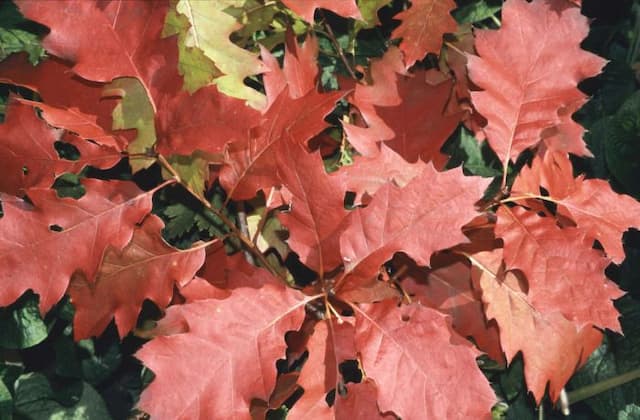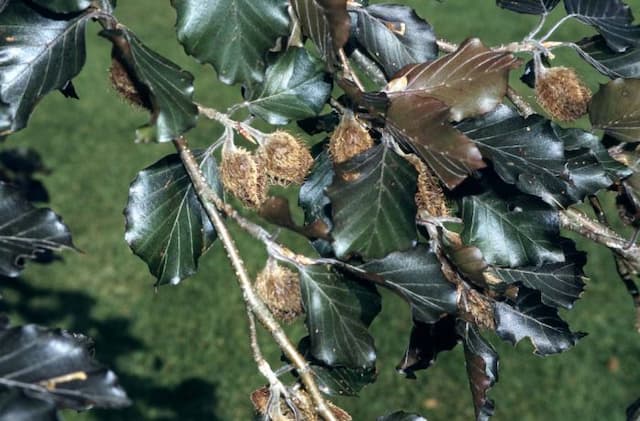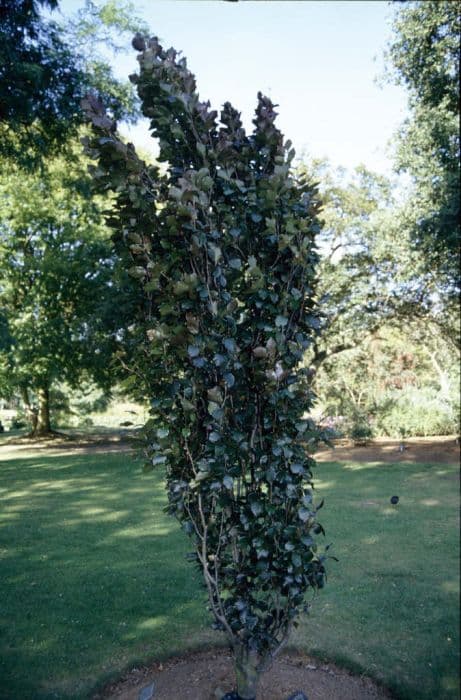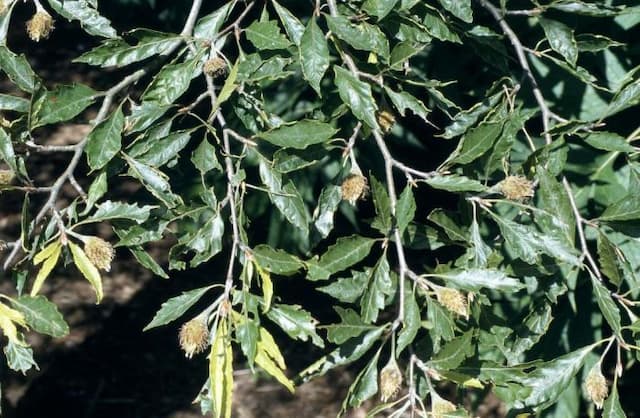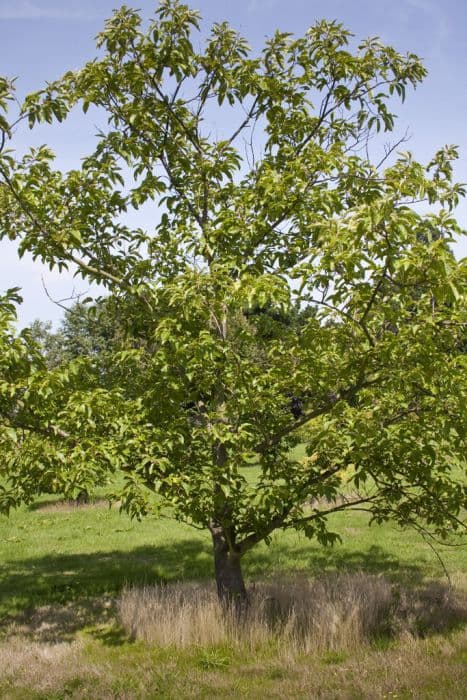Pontine Oak Quercus pontica

ABOUT
Quercus pontica, commonly known as Pontic oak, features a robust and broad canopy with a complex structure of branches. Its leaves are a notable characteristic; they are deciduous, displaying a rich green hue during the growing season and turning to a variety of warm colors in the fall. The leaves are oblong with a wavy margin and a texture that may feel slightly leathery to the touch. Along the edges of each leaf are distinct tooth-like lobes, which add to the ornamental appeal of the tree. Flowers of the Pontic oak are not showy and are typically arranged in catkins, which appear with or just after the new leaves in spring. It is a monoecious species, meaning that it has separate male and female flowers on the same plant. The acorns of the Pontic oak are also of interest; they start green and mature to a deep brown, nestled in a woody, scaled cup that attaches to the branches. These fruits are an important food source for local wildlife and contribute to the tree's reproductive cycle. Overall, the Pontic oak is admired for its attractive foliage, its structural branching habit that provides ample shade, and its role in the ecosystem as a source of food and habitat for various species. Its acorns, leaves, and overall form make it a distinctive and recognizable feature in the landscapes where it grows.
About this plant
 Names
NamesFamily
Fagaceae
Synonyms
Pontic Oak, Armenian Oak
Common names
Quercus balsamea, Quercus pontica var. balsamea, Quercus pontica var. kurdica, Quercus kurdica, Quercus pontica subsp. balsamea.
 Toxicity
ToxicityTo humans
Quercus pontica, commonly known as the Pontine oak, is not typically considered a highly toxic plant to humans. However, like other members of the Quercus genus, it produces acorns that contain tannins, which can be toxic in large amounts. Ingesting significant quantities of acorns can lead to gastrointestinal upset, with symptoms such as nausea, vomiting, and diarrhea. Severe poisoning is rare but can result in kidney damage, although most instances of human ingestion do not lead to serious consequences.
To pets
Quercus pontica, the Pontine oak, is also potentially toxic to pets, particularly dogs and cats, due to the tannins in the acorns. If ingested in large amounts, acorns can cause stomach discomfort, vomiting, diarrhea, and lethargy. In rare cases, more serious symptoms like kidney failure can occur, although pets typically do not consume enough acorns to cause life-threatening issues. Owners should still exercise caution and prevent pets from consuming acorns from the Pontine oak or any other oak species.
 Characteristics
CharacteristicsLife cycle
Perennials
Foliage type
Deciduous
Color of leaves
Green
Flower color
Varies
Height
25-40 feet [7.6-12.2 meters]
Spread
20-30 feet [6-9.1 meters]
Plant type
Tree
Hardiness zones
6
Native area
Turkey
Benefits
 General Benefits
General Benefits- Ecosystem Support: Quercus pontica, commonly known as the Pontic oak, provides habitat and food for a variety of wildlife, including birds and insects.
- Shade and Shelter: Its broad canopy offers shade and shelter, which can be particularly beneficial in urban and landscaped environments.
- Soil Improvement: The Pontic oak helps to enrich the soil through leaf litter which decomposes and adds organic matter.
- Water Management: Like many large trees, it can help with water management by intercepting rainfall and reducing runoff.
- Carbon Sequestration: As a large perennial plant, the Pontic oak captures carbon dioxide from the atmosphere, helping to mitigate climate change.
- Aesthetic Value: With its distinctive leaves and attractive form, it contributes to the aesthetic appeal of landscapes and gardens.
- Cultural Significance: It can have cultural or historical importance in certain regions, being part of local traditions or folklore.
 Medical Properties
Medical Properties Air-purifying Qualities
Air-purifying QualitiesThis plant is not specifically known for air purifying qualities.
 Other Uses
Other Uses- The wood of the Pontic oak can be used for making high-quality charcoal, which is valued for its long and steady burning properties.
- Pontic oak bark is rich in tannins and can be used in the tanning industry to produce leather goods.
- The acorns from the Pontic oak, like many other oak species, can be ground into flour and used as a food source in times of scarcity.
- In traditional carpentry, the wood of the Pontic oak may be crafted into durable furniture due to its strength and attractive grain.
- Because of its robustness, the timber from Pontic oak is sometimes used in construction, especially for outdoor structures that require weather resistance.
- The Pontic oak leaves can be used to create a natural dye for textiles, yielding various shades of brown depending on the mordant used.
- Given its dense foliage, the Pontic oak can be planted as a shade tree in parks and large gardens for recreational areas.
- The tree is sometimes used in landscape architecture to provide an aesthetic natural element within urban design projects.
- In some cultures, the acorns of Pontic oak may also be roasted and used as a coffee substitute or additive.
- The aesthetic quality of Pontic oak leaves, with their deep lobes, makes them suitable for decorative pressed leaf art and botanical displays.
Interesting Facts
 Feng Shui
Feng ShuiThe Pontic oak is not used in Feng Shui practice.
 Zodiac Sign Compitability
Zodiac Sign CompitabilityThe Pontic oak is not used in astrology practice.
 Plant Symbolism
Plant Symbolism- Strength: The Pontine Oak, like other oaks, is often associated with strength due to its robust wood and sturdiness.
- Endurance: The long lifespan of the Pontine Oak signifies the ability to endure and withstand challenges over time.
- Wisdom: Oaks have traditionally been seen as symbols of wisdom, with ancient cultures often regarding them as sacred beings that possess deep knowledge.
- Nobility: The majestic presence of the Pontine Oak is frequently linked to nobility and the qualities of honor and respect.
 Water
WaterThe Pontic oak (Quercus pontica) requires moderate watering, with a preference for well-drained soil conditions to prevent root rot. During the growing season, it's best to maintain consistently moist soil without waterlogging. Provide about 1 to 1.5 gallons of water per week depending on rainfall and soil drainage, and adjust the amount during periods of drought or excessive rain. In winter, reduce watering frequency to allow the soil to partially dry out before watering again. Young trees may require more frequent watering to establish their root systems, while mature trees can rely more on natural precipitation.
 Light
LightThe Pontic oak (Quercus pontica) flourishes best in full sunlight to partial shade. An ideal spot would offer direct sunlight for at least 6 hours a day, which helps maximize growth and foliage health. However, it can tolerate some light shade, particularly in the hotter parts of the day or in areas with intense summer sun. Placement in a location with morning sunlight and afternoon dappled shade can also be beneficial for the trees' well-being.
 Temperature
TemperatureThe Pontic oak (Quercus pontica) is a hardy tree that can withstand a range of temperatures. This species is comfortable in a temperature range between 20°F to 90°F, with an ideal climate being moderate to warm. Frost and sudden temperature drops below 20°F can be harmful, especially to younger trees. Mature Pontic oaks are resilient and can endure colder winters, but it is important to avoid extreme and sustained freezes.
 Pruning
PruningThe Pontic oak (Quercus pontica) should be pruned to remove dead, diseased, or broken branches for healthy growth and aesthetic purposes. Pruning is best done during the dormant season, typically in late winter to early spring, to avoid sap bleeding and minimize the risk of disease. Occasionally, light pruning can be done in summer to correct growth or remove unwanted branches. For mature trees, pruning every 2 to 3 years is generally sufficient to maintain shape and health.
 Cleaning
CleaningNot needed
 Soil
SoilThe Pontic Oak prefers well-draining soil with a slightly acidic to neutral pH between 5.5 and 7. A mixture of loamy soil, compost, and coarse sand or perlite will promote healthy growth. Regularly check the soil pH to ensure it remains optimal for the tree.
 Repotting
RepottingThe Pontic Oak, being a large tree, is not commonly repotted. Young trees may need repotting every 2-3 years until they are established enough to be planted in a permanent outdoor location.
 Humidity & Misting
Humidity & MistingThe Pontic Oak is adaptable to a wide range of humidity levels; however, it thrives best in moderate humidity typical of its natural forest habitats. No specific humidity level is necessary for mature trees.
 Suitable locations
Suitable locationsIndoor
Provide large space, ample light, can be challenging indoors.
Outdoor
Plant in well-draining soil, full sun, protect when young.
Hardiness zone
6-9 USDA
 Life cycle
Life cycleQuercus pontica, commonly known as Pontic oak, begins its life cycle with seed germination, typically occurring in the spring following a period of cold stratification, which breaks the seed's dormancy. The seedling stage follows, where young oaks establish a root system and a shoot, gradually developing leaves and beginning photosynthesis. As it enters the sapling stage after a few years, the Pontic oak experiences significant growth in both height and girth, and the structure of the tree becomes more complex, including the development of branches. The mature stage sees the oak reaching full size, developing a thick trunk and extensive crown, and beginning to produce acorns after around 20-30 years, which are dispersed by gravity and animals. During the reproduction stage, the Pontic oak will flower and produce acorns annually, contributing to the next generation of oaks. In its final stage, the oak may live for hundreds of years, with the eventual senescence and death characterized by reduced growth, decline in health, and ultimately, the breakdown of structural integrity.
 Propogation
PropogationPropogation time
Spring-Early Summer
The most popular method of propagating the Quercus pontica, commonly known as the Pontic oak, is by seed. The optimal time for sowing Pontic oak acorns is in the autumn, immediately after collection to prevent the seeds from drying out and losing viability. Acorns should be planted in a well-drained nursery bed or pots at a depth of about 1 to 2 inches (2.5 to 5 centimeters), and spaced adequately to allow for seedling development. Germination typically occurs in the spring following winter stratification that the acorns naturally undergo in the soil, mimicking the seasonal cycle in their native habitat. Once the seedlings have developed a strong root system, they can be transplanted to their final location. Seed propagation has the benefit of producing genetically diverse offspring, which can lead to greater resilience of the species in various environments.
